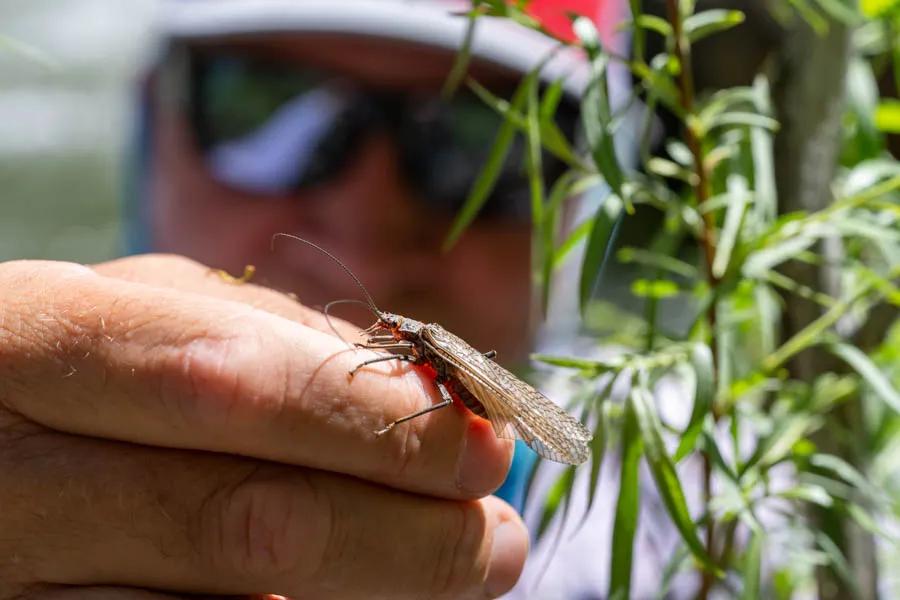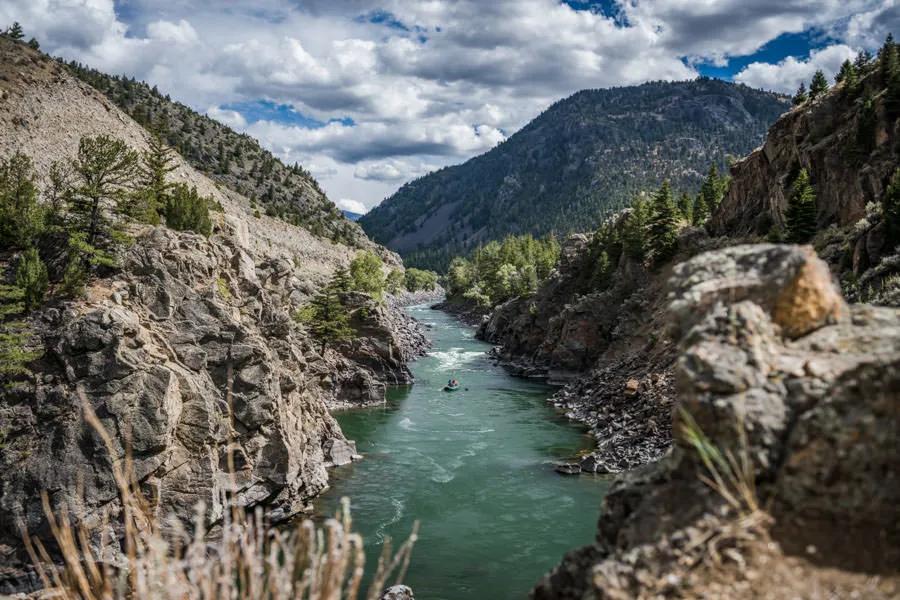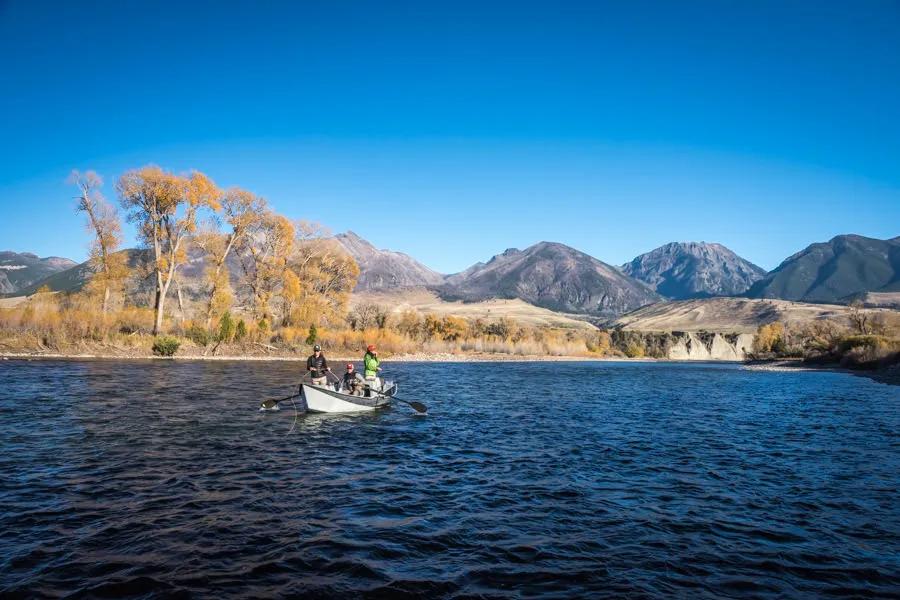
Often times Montana fly fishing guides are asked which Montana river is their favorite. Most fly fishing guides in Montana answer with, "the one I am fishing." That may be a gross over-simplification to the answer, but with so many rivers in Montana to fly fish, is it really fair to ask a Montana fly fishing guide to choose their favorite? For many long-time veteran Montana fly fishing guides one river is always near the top of the list--the free-flowing and majestic Yellowstone River.
From its source in the wilderness south of Yellowstone National Park to where it meets the Missouri River in North Dakota, the Yellowstone River is the Lower 48’s longest free flowing, undammed river. It is arguably the state's most dynamic, ever-changing fishery because of its often long and violent snowmelt runoff, including an epic 500 year flood in 2022. Home to its namesake species of native cutthroat trout and arguably the most accessible river in the West, any serious angler should want to fish the mighty “Roche Juane”—the original name given to it by French trappers and traders--at least once in their lifetimes. Here is the Montana Angler Guide's Guide to fly fishing the Yellowstone River.

Overview of Fly Fishing on the Yellowstone River
From its source to where it enters Montana, the river is accessible via public lands. Once it exits the park, multiple Forest Service, Bureau of Land Management, and Montana Fish, Wildlife and Parks access sites provide opportunity to float or walk-and-wade the river. Camping is also allowed at many of these access sites. Once the river nears Columbus access points are fewer and farther apart, but are available about every 10 to 15 miles. The river is home to native Yellowstone cutthroat trout, native Rocky Mountain whitefish, brown and rainbow trout, and a few other non-game fish. The Yellowstone cutthroat is a subspecies of cutthroat trout found only in the Yellowstone River drainage. Anglers from around the world travel here just to catch this subspecies. Since a dam does not impede the river, its course often changes from year to year. As the high flows of runoff carve out new channels or close off existing ones, the river is always changing. Your first float or wading experience after runoff can feel like an exploratory mission.

Hatches for Fly Fishing on the Yellowstone River
The Yellowstone River is home to perhaps the most famous hatch of all Western trout rivers--the giant flying salmonfly hatch. The Yellowstone River is home to Montana’s largest habitat for salmon- and stoneflies. These river-dwelling insects hatch en mass as runoff subsides and the trout respond by binge feeding for days to weeks during the insects’ emergence. From the water near Livingston, upstream to Yellowstone Lake in the park, it’s not uncommon to have two to three weeks of big dry-fly fishing using salmonflies or golden stoneflies. These hatches typically start in late June, which means local fly shops and guides now have salmonflies on the brain. When fishing this hatch use shorter, stouter leaders and focus on fishing the banks.
Midges (aka Chironomids)
Midges can provide the first early dry fly activity on the Yellowstone River. Good midge fishing on the Yellowstone tends to occur on bluebird late winter or early spring days in February, March or early April.
Blue Winged Olives (aka Baetis or BWOs)
These mayflies hatch in spring and fall on the Yellowstone River from Gardiner downstream to Billings, with the strongest hatches occurring from the Yellowstone Park Boundary to Columbus. Beginning in late March and lasting through May and again in mid-September lasting well into October, these mayflies can hatch on any day during those two seasonal windows.
March Browns
The emergence of March Browns on the Yellowstone is sporadic. However, they begin to hatch on the entire length of the river in mid- April and can be seen throughout May. Conditions must be ideal—overcast, water temperatures between 43 and 47 degrees F, and light winds.
Caddis
Caddis, and one hatch in particular—the Mother’s Day caddis hatch—are famous on the Yellowstone River. An abundance of caddis species live in the Yellowstone and attempting to name them all would be cumbersome and mind-blowing. The famous Mother’s Day caddis hatch on the Yellowstone River can begin in late April, but most years the hatch begins around its namesake. However, river conditions and the ability to fish the hatch depend when snowmelt runoff will begin.

Golden stoneflies
On the Yellowstone River, golden stoneflies provide plenty of action for dry fly anglers. These large—size 8 to 12—aquatic insects emerge slightly later than salmonflies. Beginning in late June and lasting into mid-July, a golden stonefly hatch occurs in the same sequence as a salmonfly hatch, however golden stoneflies are smaller.
Yellow Sally stoneflies
These stoneflies may hatch concurrently with salmonflies and Golden stoneflies. Often mistaken for caddis or PMDs this small stonefly is a crucial part of a Yellowstone River trout’s diet. Yellow Sally stonefly nymphs become active in late June, with adult insects hatching from late-June well into early August.
Pale Morning Duns
An abundant mayfly in the Yellowstone River from Columbus to Gardiner, hatches of Pale Morning Duns (PMDs) begin in late June and last all through July. Primarily found in the river’s riffles and longer runs, PMDs emerge when water temperatures hit 58 degrees F.
Trico mayflies
These small mayflies are primarily important for dry fly anglers who enjoy casting very tiny flies—sizes 18 to 22—to rising trout. Tricos hatch at sunrise and an emergence rarely lasts longer than a few hours. They hatch from bankside structure or in riffles.
Terrestrials: Grasshoppers, ants, and beetles
On the Yellowstone River as summer moves on, hatches become more sporadic and less predictable. Grasshoppers, ants, and beetles dominate a trout’s diet by late July. Having been blown into the river these land-dwelling insects are a common occurrence on the Yellowstone River.
October caddis
These late season caddis are exciting to see, however, their emergence is sporadic. October caddis on the Yellowstone River can hatch as early as late September and will typically peak in late October.

Sections for Fly Fishing on the Yellowstone River
The Yellowstone River begins south of Yellowstone Lake just outside the southern border of Yellowstone National Park. It is fitting the heart of the Yellowstone River lies at the place in the Lower 48 that is the furthest from any road. It is here some thirty miles from where any vehicle can travel, that the wilds of the Yellowstone River begins. Some great fly fishing water on the Yellowstone River exists inside Yellowstone National Park, but since one of the great appeals of the Yellowstone River is to float and fish it, we are featuring the sections where floating is allowed.
Yellowstone River from Gardiner to Yankee Jim Canyon
The abundance of native Yellowstone cutthroat trout helps to make this stretch one of the best for finding consistent dry fly action. In the spring, baetis and caddis hatches rule the show until run off hits in early or mid May. Once run off subsides, the attractor dry fly fishing with big bushy foam salmon flies can be epic. By the end of July the hopper fishing kicks in and on a windy afternoon you will see dozens of the terrestrials getting blown into the water from the high sage flats above the water. Fishing remains good well into the fall when the baetis mayflies bring pods of fish to the surface on cloudy days.
Yellowstone River in Yankee Jim Canyon
This section has some class III whitewater that can flip inexperienced boaters so caution is advised and rafts are highly recommended (vs. drift boats). The big canyon water needs to drop to lower levels than the rest of the river before it begins to fish well which usually happens in mid July. The fish make up is dominated by cutthroats and rainbows with a handful of browns. The complex currents, boulders and monstrous eddies make for interesting fishing. A guided fly fishing trip in the canyon is a fun way to mix in some scenic whitewater with some great fishing.

Yellowstone River in Paradise Valley
This section of the river is the first to begin fishing well when run off ends because of the gentler flows. Good fishing can be had at flows as high as 10,000 cfs. The flows are much more uniform in the Paradise Valley section which makes it a great float for beginning anglers. Scenery is nothing short of spectacular with the snow capped peaks of the Absaroka and Gallatin ranges towering overhead on both sides of the river valley. Cutthroat trout populations start to drop off after Carbella and do not dominate the fish count once you move farther downstream from the Carbella boat ramp. The Paradise Valley floats can produce some very large brown trout for a few lucky anglers.
Yellowstone River: The Livingston “Town Stretch”
The Yellowstone changes character as it flows from the lower Paradise Valley section into and around the town of Livingston. The “Town” stretch has some of the most interesting water on the river with multiple channels, gravel shelves, seams, eddies and riffles. The town stretch is also close to the mouth of the Armstrong and Nelson spring creeks which are major spawning grounds for rainbow trout. The varied habitat and the proximity of spawning gravel in the spring creeks combine to produce some of the highest rainbow trout counts on the entire Yellowstone River. This section has also produced a few 15 lb. browns. The best fishing on the town stretch occurs when the river has dropped below 7,000 cfs due to the higher gradient here.
The Lower Yellowstone River from Livingston Down
Trout numbers slowly drop as the river gets farther from Livingston with the exception of the floats around the Boulder River mouth near Big Timber which also adds spawning habitat for rainbows. The brown trout populations on the Yellowstone are lower than cutthroats or rainbows but they are more stable in numbers on the different sections of the lower river. Browns also tend to be the largest fish in the river, although some monster rainbows in the 20-25” class are caught with some frequency. The lower river has a blend of large sweeping riffles, gravel shelves, long swift runs and slow pools. There are also several large islands which produce smaller side channels that can often be productive. The river valley is much more open and the mountain views are more distant. The lower river can produce some outstanding hopper fishing and late season opportunities for baetis mayflies in the fall.

Seasons for Fly Fishing the Yellowstone River
Except for a long snow melt runoff, the Yellowstone River has one of the longest seasons for consistent fly fishing of any river in Montana. Many local guides begin to float fish the river in early March even when huge chunks of self ice are still blocking many boat ramps. Some of the year's largest brown trout are caught in March by fly fishing guides dragging or dead-drifting streamers. After snowmelt runoff and well into November, the Yellowstone River can be a great option on any given day.
Spring: March up Until Snowmelt Runoff Begins (Usually mid-May)
March, April, and May can produce some of the most exciting fishing of the year on the Yellowstone River. Baetis mayflies (or Blue Winged Olives) hatch in mid-April and can produce outstanding dry fly fishing during cloudy days. In late May the larger size 12 march browns begin to show up. Although they are never in as great of abundance as the baetis; the trout often key in on them heavily and the larger insect also entices larger trout to the surface. April is also an ideal time to strip or dead drift streamers for some of the largest trout in the river. In early May the famous Mother’s Day Caddis hatch starts to come off in great abundance. This explosive hatch is the most intense of the year and attracts anglers from far and wide.
Early Summer: late June and early July
The duration of run off depends greatly on the snow pack. The Yellowstone River is often the last river in Montana to clear from run off. When the Yellowstone finally comes around the trout haven’t seen pressure in over a month which helps this river to produce some of the best mid summer fishing in the region. The Yellowstone first produces reliably good fishing when flows hit 10,000 cfs. Often this coincides with the salmonfly hatch but every year is different and some years flows are much lower than 10,000 cfs when it clears. Fishing at 8,000-10,000 cfs is mostly a nymph fishing or streamer game and expect to loose a lot of flies because the trout will be right against the bank along the willows. The river drops quickly in the post run off stage and phenomenal attractor dry fly fishing begins as soon as the river hits 8,000 cfs.

Late Summer: Late July and August
Yellowstone River fly fishing is famous for its hopper fishing. Once the bulk of the aquatic hatch cycles finish sometime in mid to late July fishing grasshoppers and ants become a major staple for Yellowstone trout. The timing of the initial wave of good hopper fishing varies from summer to summer and can begin as early as mid July or as late as the first week of August. There is also a late hatching stonefly called the nocturnal stone that hatches at night on the Yellowstone in late July. Stonefly nymphs such as Pat's Rubber Legs are often productive during this period and sometimes hopper patterns are taken for this insect.
Fall: September through November
In the fall the river is lined with yellow leaved cottonwoods and the surrounding mountains are often freshly dusted with the first high elevation snows of fall. Brown trout are fall spawners and the largest fish in the river let their guard down as they become preoccupied with reproductive activities. Casting large streamers on cloudy fall days can produce some heart stopping strikes from trophy sized fish. Fall is also a great time to cast dry flies. The fall baetis hatch encourages pods of rainbows to sip the small mayflies out of current seams and eddies. With few other anglers on the water and productive fishing and the prospect for some massive trout is very real, fall can be a great time to fish the Yellowstone River.
The Yellowstone River flowing out of Yellowstone National Park and down to Billings, Montana is one of the most variable rivers in Montana with a huge range of water flows and fishing conditions. Casting a fly on the Yellowstone River at 11,000 cfs vs. 1,500 cfs is quite a different experience. Because of the massive amount of water that the river has to offer, the wide range of water levels, the diversity in the river sections, and the seasonal changes in fishing patterns the Yellowstone River can take years before a fly fisher truly understands the full majesty of this amazing river--but that is also one of the biggest appeals. The diversity, changing character, and quality of fishing that the Yellowstone River offers makes it a favorite of many of our Montana fly fishing guides.
